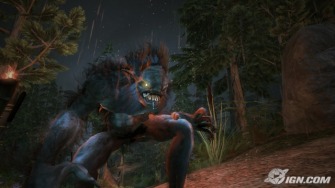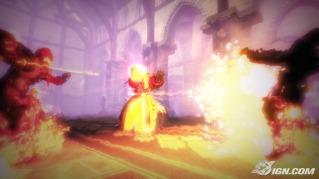Fable II: The First Three Hours

September 15, 2008 - It's been four years since the release of Fable, an RPG that promised (and failed) to reinvent the wheel. Despite not living up to Peter Molyneux's lofty promises, Fable was still a critical and commercial success. For the sequel, Molyneux is trying to hold the grandiose comments to a minimum. We know we're going to love our dog, that we'll have unique drop-in and drop-out online co-op, and that the combat is simple on the surface, but has some depth. That much we've seen. Surprisingly, there's a lot of Fable still to be discovered.
I had the chance to delve into the world of Albion, experiencing the first three hours of Lionhead Studios' upcoming RPG. The first 30 minutes of your adventure take place in childhood. At the start there are no customization options and limited combat abilities. You can be a girl or a boy, which changes some of the pronouns in spoken dialogue, but doesn't otherwise alter the course of events. Your child hero will look like mine and your neighbor and your neighbor's neighbor. The first 30 minutes will be pretty similar for just about everyone, though there are a few morality choices to make that have long-lasting ramifications.
You can, for example, choose to collect five missing warrants. Once collected, you can be a good Samaritan and return them to the sheriff. Or you can go the naughty route and give the warrants to the leader of a gang of bandits. As a child, you won't see the consequences of these actions, but this choice is significant. Later on you will return to Bowerstone and see the results of your choice. Turning in the warrants to the authorities leads to a crackdown on villainy and made Bowerstone a more powerful city for commerce. Go the opposite route, and the lower ward of Bowerstone is a cesspool for bandits. That does open some assassination side quests if you want to follow the path of evil, but will also shrink the markets in Bowerstone.
This change is something you'll discover two or three hours into Fable II. Before you get to this point, you'll need to settle on a path to heroism. Your formative years have been spent in a gypsy camp. Now that you're old enough to go out on your own, you must leave the camp and begin your mission to bring down Lucien before he can hatch his evil (and yes unrevealed) plans to conquer Albion. With you is your trusty dog, who will never betray you and will never leave your side. Just as your character can upgrade stats and improve in various areas, your dog can be upgraded to become more combat effective. And just as your character morphs as decisions are made, so too will your dog slowly morph to match his owner's disposition.
The first few hours of Fable II will lead you quite a bit. While you can do some exploration, you're not going to get far without following directions and heading to the underwater tomb to test your hero skills. In this subterranean testing ground, you'll learn the basics of combat and gain the ability to use magic. You'll also find links to the original Fable, if you're a hawk-eyed explorer (and bookworm).
Even in this earliest stage, you can begin shaping your hero. Four types of experience are earned by killing enemies. You get general experience and then experience specific to strength, skill, and will, depending on how you approach combat. Use your sword and you earn experience only usable for strength upgrades. Your bow or gun gives you will experience and using magic to kill enemies earns you will bonuses.
The upgrade system is fairly robust. From the outset there's about a half-dozen spells you can learn. These include fire, lightning, vortex (sucks in enemies), slow time and force push. For strength, you can increase your health, boost your strength and add new functionality to your melee attacks (add flourishes, use the environment in combat, etc.). Skill is used for ranged combat and can increase your accuracy, speed of reloading, and other similar aspects.
Combat is easy to get into and, once you start upgrading, is a lot of fun. Though I never found any real challenge in my three hours of play, I did have a blast kicking the crap out of hobbes and bandits. The magic is the real innovation here. There is no mana meter. There is no wait time for magic to refresh. You can keep tapping the magic button (B) just as you would naturally tap X for sword slashes. It's surprisingly refreshing to not have to micromanage magic and to have it on equal footing with other areas of combat.
As you earn new levels in your powers, you'll need to hold the B button to charge your attacks. In the first three hours, though, you'll likely be at level 1 in everything. So you just keep tapping. Point in a direction and you can aim an attack at one foe or leave the thumbstick in neutral for an area effect attack.
Being independent of mana helps a great deal for combining your different types of attacks. This is where you can gain some serious style points (and combat multipliers). I like to slow time, then switch to force push. Tap it a few times to knock an enemy back to the edge of a cliff, then whip out my shotgun with a tap of the Y button and pop him in the face as he's falling. Fable II combat is very fluid and feels as if it will be quite amazing once you are fully powered.
Even though you feel the heavy hand of a developer guiding you in the first few hours, there are opportunities for exploration. Though the world is not as wide open as a game like Oblivion, there are lots of divergent paths. On your way to the next mission, it's easy to be distracted by temptations leading you off the proverbial Yellow Brick Road. Though I had just a few hours to play, it was difficult not to wonder, "What's in that house over there?" Or, "Is that a Demon Door beyond that line of trees?" Using the map, you can set a breadcrumb trail to your next quest. While I first groaned at this idea, now I respect the decision. Having a trail frees you to explore anything at any time. No matter how much your path diverges, you can turn around at any time and have the trail put you back on track.
And yes, there are Demon Doors again. These talking doors hold gifts and secrets that can only be earned by satisfying the Door's request. I found three doors quite easily, meaning there are likely many more hidden around Albion. The Thespian door wants someone who can act out his story, using gestures. The numerous gestures need to be learned through your travels, so this is a door that will need to be revisited later on.
This is a bigger, more interesting world than the one given to us in the first Fable. It's yet to be seen just how large the world is or how much there really is to do in Albion, but my hopes have risen after playing the first three hours. Even the towns have more to do. You can purchase any real estate you see, perform odd jobs, have a sculptor make a statue of you to place in town, and of course talk to people and earn side quests.
Now, the job stuff may sound intriguing, but it was actually the most disappointing element of my time with Fable II. Every job I found brings up the same curved meter. Your job is to hit the A button when the target is in the sweet spot on the meter. Whether you are making swords or chopping trees, it seems to be the same thing. While this is a good way to earn money, it gets boring pretty fast. The best way to earn some cheddar is to buy a shop, set the price of goods, and watch the coin roll in.
You can have some fun with this. Buy the local bar and you can make beer free. No, you won't earn any cash, but the whole town will be sauced and everyone will love you. Ah, but how can you buy a bar so early in Fable II? Well, you can bring in your money from Fable II Pub Games. You may even have used the well-known cheat to earn your dough. Just be warned. Molyneux has said that the cheat was no accident and that those who used it to earn their money will be in for a surprise.
It's only around the three hour mark when Fable II opens up and Lionhead's guiding hand eases off a bit. Though you'll have had several good/evil choices, it's at this point that you start seeing a clearly divergent path. You'll find the Temple of Light, with its peaceful monks and their various side quests (which, oddly, have you killing lots of people). You'll also come across the Temple of Shadows, a place that will make it very difficult for gamers to stay on the path of good.
Being accepted into the Temple of Shadows is a laugh. You just have to eat five live chicks. It will skew you evil rather quickly. Once the chicks are eaten (as simple as hitting right on the d-pad five times) you are granted access. Inside the Temple of Shadows is the wheel of fate. This wheel, which has around a dozen or so different deaths, will be the undoing of many a wishful do-gooder. To rise in the ranks of the Temple of Shadows, you must sacrifice people to the wheel of fate. That means convincing someone to trust you enough to follow you to the circle of sacrifice. Once there, you pull the lever and the wheel determines the horrific circumstances of their demise.
Bonus points for sacrificing your spouse.
Three hours isn't a lot of time to spend with an RPG. Even though Molyneux expects Fable II to take 12-15 hours straight through, there's plenty more that will distract you. Just getting through three hours without wasting my time playing with my dog or chatting up girls at the pub was a challenge. It remains to be seen if Fable II can live up to its promise, but three hours in, it's looking like it will at least be one of the best RPGs of '08.
Thanks for Reading :)


